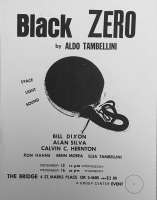Abstract
The expanded cinema event Black Zero (1965–1968)—a collage of jazz improvisation, light projection, poetry reading, dance performance, and televisual noise—was produced collaboratively by the artist Aldo Tambellini and his partner Elsa Tambellini, members of the anarchist anti-art group Black Mask, numerous jazz musicians, including Bill Dixon and Calo Scott, and poets associated with the Umbra group of the Lower East Side, an early progenitor of the Black Arts Movement. The work represents the culmination of a series of performances begun in 1965, all variations on the theme “black.” These works deployed blackness—as a chromatic resonance, a hue, a skin color, and an idea—in order to address the rise of Black Liberation within a multisensorial “environment.” In what follows, I discuss Black Zero’s attempt to formalize an alternative to the problem, raised by black activism, of being positioned by representational thinking. I show how this monochromatic abstraction of abundance also responded to the new iconicity of black militancy facilitated by the televisual presence of Black Power. Against the modernist fantasy of black as a noncolor liberated from signification, the electromedia environment dramatized the ways in which the politics of Black Liberation and the rise of the Black Arts Movement intervened in formalist uses of the color black in 1960s art practices—to multiple and contradictory ends. Following Anne Anlin Cheng’s important move “away from the visibility of race” and toward an account of “its visuality,” I suggest that the “problem” of racial difference structured Black Zero’s deployment of expanded cinema. Interrogating the complicated valences between the surfaces of the skin and the painted canvas, the black box, and Black Power, the expanded cinema environment dramatized the very border of art and life through its treatment of race as itself a new technology of vision.


